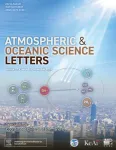China focuses on improving air quality via the coordinated control of fine particles and ozone
2024-11-26
(Press-News.org) A recent special issue of the journal Atmospheric and Oceanic Science Letters has brought together some of China's top scientists to provide a picture of the latest progress in understanding and controlling air pollution.
Fine particulate matter, referred to as PM2.5, and ground-level ozone (O3) are the main pollutants degrading the air quality of China’s cities and wider urban regions. Both have serious human health effects, such as heart disease, asthma, and lung damage.
The World Health Organization (WHO) provides clear guidelines regarding acceptable concentrations of PM2.5 and O3. However, despite some success in lowering PM2.5 levels following certain policy implementations, O3 levels in China have continued to rise, and not one city in China is meeting the WHO's targets for either of these two pollutants.
The ways in which PM2.5 and O3 are formed in the lower atmosphere are intricately linked, sharing common precursor compounds. In addition, once formed, the two pollutants interact with each other via various atmospheric pathways.
Much progress has been made in China to understand the sources of PM2.5 and O3 and how their concentrations vary in the air breathed by its urban populations. Nevertheless, many challenges and gaps in knowledge remain.
One clear message cutting through from scientists is that, rather than focusing separately on either PM2.5 or O3, coordinating their control is central to further improving China’s air quality. The approach is, quite literally, a breath of fresh air.
This special issue of Atmospheric and Oceanic Science Letters was organized to address the major scientific challenges that remain in understanding the chemical and physical processes that contribute to the formation of PM2.5 and O3. In doing so, the door is then opened to developing strategies and policies towards their coordinated control and, ultimately, better air quality for China's urban populations.
"The issue is structured according to several different key themes", explains Prof. Likun Xue, a scientist based at Shandong University and one of the three Editors of the special issue. "There are papers on the spatiotemporal variability of PM2.5 and O3 pollution, the effects of heatwaves, the chemical mechanisms and sources of precursor compounds, and even the development of a new instrument for measuring O3 and its precursors".
Taking one of those themes as an example, like many forms of extreme weather, heatwaves are becoming more frequent and severe under climate change. This has a tangible impact on O3 pollution because of its temperature-driven chemical production. This link underscores the need for improved strategies to manage O3 as part of efforts to mitigate the effects of future climate change.
Overall, this special issue offers valuable insights into our current understanding of the elaborate mix of factors that interact to ultimately determine the formation and patterns of these two key air pollutants in urban China.
"Moving forward, the coordinated control of PM2.5 and O3 will be a critical part of China's efforts to reduce pollution and mitigate carbon under the country's 'Carbon Neutrality' framework," concludes Prof. Xue.
END
[Attachments] See images for this press release:

ELSE PRESS RELEASES FROM THIS DATE:
2024-11-26
SAN FRANCISCO—November 26, 2024—Subtle signs of Alzheimer’s disease can emerge decades before a diagnosis—often in the form of irregular behaviors that reflect very early stages of brain dysfunction.
But until now, identifying and measuring these slight behavioral changes in a scientific way hasn’t been feasible, not even when studying Alzheimer’s in mice.
In a study published in Cell Reports, a team of scientists at Gladstone Institutes used a new video-based machine learning tool to pinpoint ...
2024-11-26
UCSF Benioff Children's Hospital Oakland is enrolling patients in an innovative clinical trial that seeks to cure sickle cell disease. The trial is the first in the U.S. to apply non-viral CRISPR-Cas9 gene-editing technology in humans to directly correct the genetic mutation that causes the disease.
The research involves taking the patient’s blood stem cells to correct the mutation and returning those edited cells to the patient through a bone marrow transplant. It’s hoped the corrected blood stem cells will then multiply and create a new blood system, one free of sickle cell.
“This ...
2024-11-26
Gene editing could create hypoallergenic cats, according to a sequence analysis of the protein that triggers allergies to cats. Some 15% of people are allergic to cats, and symptoms can be severe. Martin D. Chapman and colleagues investigated CH1 and CH2, genes that code for the allergen, Fel d 1. Cats produce Fel d 1 in their sebaceous, salivary, perianal, and lachrymal glands. The function of Fel d 1 is unknown but comparisons of Fel d 1 sequences and homologs from 276 domestic or exotic cats—including cougars, cheetahs, lions, tigers, and jaguars, among others—suggests that CH1 and CH2 have been under active selection, and ...
2024-11-26
The demand for electronics has led to a significant increase in e-waste. In 2022, approximately 62 million tons of e-waste were generated, marking an 82% increase from 2010. Projections indicate that this figure could rise to 82 million tons by 2030. E-waste contains valuable materials such as metals, semiconductors, and rare elements that can be reused. However, in 2022, only 22.3% of e-waste was properly collected and recycled, while the remaining materials, estimated to be worth almost $62 billion, were discarded in landfills. Although efforts to improve e-waste recycling continue, the process remains labor-intensive, and a significant portion of e-waste ...
2024-11-26
Cooling systems are an integral part of many modern technologies, as heat tends to wear down materials and decrease performance in several ways. In many cases, however, cooling can be an inconvenient and energy-intensive process. Accordingly, scientists have been seeking innovative and efficient methods to cool substances down.
Solid-state optical cooling is a prominent example that leverages a very unique phenomenon called anti-Stokes (AS) emission. Usually, when materials absorb photons from incoming light, their electrons transition into an “excited” state. Under ideal conditions, as electrons return to their original ...
2024-11-26
Thermoelectric materials, which convert heat into electricity, are valuable tools for capturing waste heat and turning it into usable electricity. These materials are especially useful in industries and vehicles where engines produce a lot of waste heat, improving energy efficiency by converting it into additional power. They also exhibit potential for portable power generation, in remote sensors and satellites where traditional power sources may be impractical.
Traditional thermoelectric devices, known as parallel thermoelectric devices, generate a voltage in the same direction as the heat ...
2024-11-26
Recent research led by Kerstin Ozkan and published in PeerJ Life and Environment has uncovered the complex and contrasting effects of human-generated noise on Western Bluebird (Sialia mexicana) parental behavior, raising critical questions about how anthropogenic noise affects wildlife in both urban and non-urban settings. The study, titled “Divergent effects of short-term and continuous anthropogenic noise exposure on Western Bluebird parental care behavior,” explores how different types of noise exposure alter the bird's ...
2024-11-26
Imagine gradually losing the ability to express yourself — not because you've forgotten the words, but because they simply won't come out. This is the reality for individuals living with primary progressive aphasia (PPA), a rare form of dementia that usually begins in middle age and increasingly impairs language abilities over time.
Researchers at the University of Chicago Medicine are working to illuminate the struggles of those living with this condition and pioneer accessible treatment models. They recently published new studies that measure PPA’s significant impact ...
2024-11-26
Let’s say it’s a home game for the Golden State Warriors and Steph Curry shows he’s still got it, sinking back-to-back three-pointers minutes into the first quarter. The fans at Chase Center take notice, and so do the betting markets, where the odds move in the Warriors’ favor.
Yet it’s a long game. The away team comes back, and with just 10 seconds to go, the Warriors are down by two and have just missed a shot. A victory is unlikely, and the betting odds should have shifted to reflect that near-certainty. ...
2024-11-26
CHICAGO – In patients with long COVID, lower pulmonary gas exchange may be associated with impaired cognitive function, according to a study being presented next week at the annual meeting of the Radiological Society of North America (RSNA).
According to the National Center for Health Statistics, approximately 17.6% of adults in the U.S. have experienced a post-COVID condition commonly referred to as long COVID. People with long COVID may exhibit a wide variety of symptoms, including difficulty concentrating (“brain fog”), change in sense of smell or taste, fatigue, joint or muscle pain, dyspnea (shortness of breath), digestive ...
LAST 30 PRESS RELEASES:
[Press-News.org] China focuses on improving air quality via the coordinated control of fine particles and ozone





